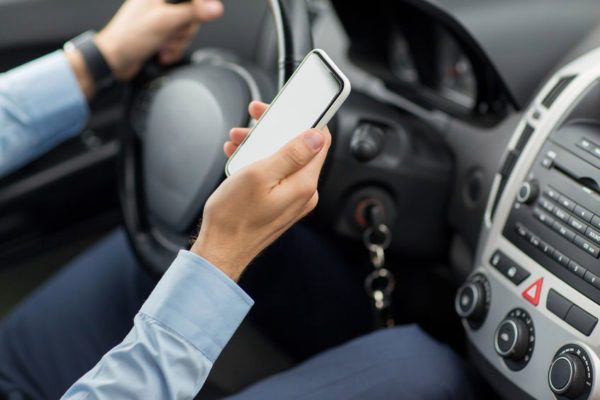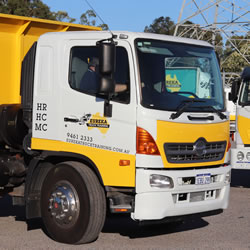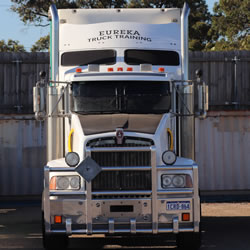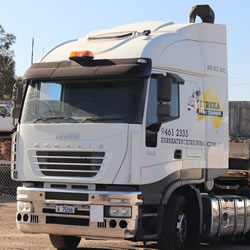We thought we would get the Eureka Truck Training blog started with a few simple road rules that everyone should know and follow, these rules are here to make traffic flow and the more importantly, keep the roads safe.
SOURCE: https://roadrules.rsc.wa.gov.au/
Merging
Where two lanes merge into one (i.e. lane lines end) the vehicle in front has the right of way.
If there are multiple marked lanes, and one ends, give way to the vehicles in the lane you are moving into.
Remember:
- Always use your indicator to signal your intentions to other drivers when merging;
- Keep a safe distance between your vehicle and the vehicle in front of you and take turns to merge if there are long lines of merging traffic;
- Try to match the legal speed of the road you’re merging into, but don’t speed up to get your vehicle ahead of others.
Merging Penalties
Failing to give way when merging = 2 demerit points and a $100 fine.
Failing to give way when changing lanes = 3 demerit points and a $100 fine.
Roundabouts
When entering a roundabout, always give way to any vehicles already in the roundabout. On multi-lane roundabouts, obey the directional arrows on the road.
Turning Left
On approach, indicate left from the left lane. Stay in the left lane and exit the roundabout from this lane.
Driving Straight Ahead
You don’t need to indicate an approach. Enter in either the left or right lane, stay in and exit from the same lane. If practicable, indicate left when you’ve passed the last exit before the one you intend to use.
Turning Right or Making a Full Turn
On approach, indicate right from the right lane. Stay in the right lane and exit the roundabout from this lane. If practicable, indicate left when you’ve passed the last exit before the one you intend to use.
You can change lanes within a roundabout, but you must indicate and give way to other vehicles.
Cyclists & Roundabouts
When entering a multi-lane roundabout, cyclists should move to the centre of their chosen lane.
Please note that in a single lane roundabout, cyclists should ride close to the left boundary of the lane.
If you’re a motorist entering a roundabout, be aware of cyclists. While in the roundabout, don’t try to squeeze past or overtake them.
Cyclist & Roundabouts Penalties
Failing to give way at a roundabout = 3 demerit points and a $150 fine.
All other offences for not using a roundabout correctly = 2 demerit points and a $100 fine.
Mobile Phones

Touching/holding includes resting on any part of the driver’s body (e,g lap). It does not include held in a pocket of the driver’s clothing or in a pouch worn by the driver.
Driving includes being stationary with the motor running (e.g. waiting at stoplights, stopping roadside).
Whilst driving, you can only touch a mobile phone to receive and terminate a phone call if the phone is secured in a mounting affixed to the vehicle. If the phone is not secured in a mounting, it can only be used to receive or terminate a phone call without touching it (e.g. using voice activation, a Bluetooth hands-free car kit, earpiece or headset).
Whilst driving, it is illegal to create, send or look at a text message, video message, email or similar communication, even when the phone is secured in a mounting or can be operated without touching it.
GPS may be used by a driver whilst driving if it is secured in a mounting and no touch of the keypad or screen is required.
The vehicle must be legally parked, with the motor turned off, before a driver can legally hold a mobile phone.
Using Mobile Phones While Driving Penalties
Using, touching or holding a mobile phone whilst driving = 3 demerit points and a $400 fine.
Creating, sending or looking at a text message, video message, email or similar communication, whilst driving = 3 demerit points and a $400 fine.
U-Turns
When making a U-turn, you must:
- ensure it can be done safely;
- use your indicator to signal your intentions to other drivers;
- give way to all other vehicles, cyclists, and pedestrians on the road you are turning into.
You MUST NOT make a U-turn:
- when you do not have a clear view of approaching traffic or it interferes with other traffic;
- at traffic lights (unless there is a ‘U-turn permitted’ sign);
- where there is a ‘no U-turn’ sign;
- on freeways, including on and off-ramps.
In Western Australia only – U-turns are allowed over a continuous white line.
U-Turns Penalties
Making a U-turn where not permitted = 2 demerit points and a $100 fine.
Failing to give way when making a U-turn = 3 demerit points and a $100 fine.
Keeping Left
On single-lane roads, you must drive as far to the left as practical (except motorcyclists). On multi-lane roads, if the speed limit is 90km/h or more you must drive in the left lane. This same rule applies to any road where there is a ‘keep left unless overtaking sign. On these roads, you can only drive in the right-hand lane if:
- you’re turning right or making a U-turn;
- you’re overtaking;
- the left lane is a special purpose lane, e.g. bus lane, bicycle lane, slow vehicle turnout lane;
- the left lane is a turning lane and you are going straight ahead;
- you’re avoiding an obstruction;
- you’re not driving a vehicle of a type that is prohibited from the right lane by way of signs (i.e. trucks);
- the other lanes are congested with traffic.
NB: On dual/multi-lane roads where the speed limit is under 90km/h, the ‘keep left’ rule only applies where there is a ‘keep left unless overtaking sign.
Fail To Keeping Left Penalties
Failing to keep left in a multi-lane road = 2 demerit points and a $50 fine.
Uncontrolled Intersections
An uncontrolled intersection is where there is no traffic signal, stop sign, or give way sign.
As
a rule, at an uncontrolled intersection, always give way to the right, to
oncoming vehicles and pedestrians.
Specifically:
- If going straight ahead – give way to vehicles on your right;
- If turning left – give way to vehicles to the right and pedestrians crossing the road you’re entering;
- If turning left using a slip lane – give way to vehicles on your right and pedestrians crossing the slip lane;
- If turning right – give way to vehicles on your right, any oncoming vehicles/bicycles who are going straight ahead or turning left, and any pedestrians crossing the road you’re entering.
Uncontrolled Intersections Penalties
Travelling straight ahead OR turning left in a slip lane – failing to give way to vehicles to the right or pedestrians = 3 demerit points and $200 fine.
Turning left or right – failing to give way to vehicles to the right or pedestrians = 3 demerit points and $300 fine.
Crossing Continuous White Lines
There are three types of single continuous (unbroken) lines:
1. Edge Lines
Are used to mark the edge of the road.
You can only cross over an edge line when entering or leaving the road or;
passing a vehicle on the left that is turning right or making a U-turn.
2. Lane Lines
Are used to define multiple lanes travelling in the same direction.
If the lane line is continuous, don’t cross the line to change lanes.
3. Centre/Dividing Lines
Are used to separate lanes travelling in different directions.
If the centre/dividing lines are continuous, do not cross that line unless you
are turning right (i.e. to leaving or entering the road) or making a U-turn.
The same applies if there is a continuous line on the left of a broken or
dotted centre line.
Exceptions: – If you are overtaking a cyclist, or you need to avoid an obstruction, you may cross the continuous centre line(s) or edge line providing you have a clear view of any approaching traffic, and it is safe to do so.
Centre/Dividing Lines Penalties
Crossing the edge line of a road = $100 fine.
Crossing a continuous line when changing lanes = 2 demerit points and a $100 fine.
Crossing a continuous centre line = 3 demerit points and a $150 fine.
Overtaking
Overtaking can be dangerous. When overtaking, make sure you have a clear view of oncoming traffic and use your indicator to signal your intentions to other drivers.
Overtaking on the Left
Permitted when:
- driving on a multi-lane road;
- directed by an authorised person (e.g. police officer);
- the vehicle(s) in the right lane is stationary and it is safe to do so;
- a vehicle is indicating that it is turning right or making a U-turn.
Overtaking on the Right
This is permitted when you’re both travelling in the same direction and you are not crossing a continuous white line.
Overtaking a vehicle on the right is NOT permitted:
- at a railway, pedestrian or children’s crossing;
- at an intersection;
- where there is a ‘no overtaking’ sign;
- where there are single or double continuous centre lines;
- where you do not have a clear view of approaching traffic.
Motorists should only overtake a cyclist when there is a clear view of the road ahead and if there’s enough space for you to pass. You may legally cross continuous white lines to safely pass a cyclist. Remember to indicate.
Remember:
When travelling on roads with a speed limit up to 60km/h, allow 1 metre between your vehicle and the cyclist to pass safely;
When travelling on roads with a speed limit over 60km/h, allow 1.5 metres to pass a cyclist.
Overtaking Failure Penalties
Failing to overtake at a safe distance = 4 demerit points and a $400 fine.
Overtaking at a railway/pedestrian/children’s crossing = 4 demerit points and a $400 fine.
Overtaking on continuous white line = 3 demerit points and $200 fine.
It is illegal to
exceed the speed limit when overtaking = penalty varies.
Failing to overtake a cyclist allowing a passing distance of 1 metre (up to
60km/h) 1.5 metres (over 60km/h) = 4 demerit points and $400 fine.
Emergency Vehicles
Emergency Vehicles Include Police, Fire and Ambulance Services
If an emergency vehicle has blue or red flashing lights and/or sounding an alarm, you MUST clear the way to let it easily pass.
When an emergency vehicle is approaching:
- stay calm and check to see where it is;
- give way to it by moving as far to the left of the road as possible;
- if you can’t move left, slow down, indicate left and let the emergency vehicle drive around you;
- use your indicator to signal your intentions to the driver of the emergency vehicle;
- if you are in the left lane, allow other vehicles from an adjacent lane to move into your lane if they need to.
When giving way to an emergency vehicle DO NOT break the law (e.g. driving through a red light or speed).
Attending roadside incidents can be risky business for workers attending roadside incidents. Flashing lights on a stationary vehicle mean approaching vehicles must slow down, move over (if possible) and pass at 40 kilometres per hour. In doing so, drivers should apply their brakes gradually and safely.
Emergency Vehicles & the Safety of Roadside Workers
This law ensures the safety of all emergency service vehicles and first response personnel who need to attend roadside incidents.
As well as emergency vehicles, this law includes tow trucks, RAC roadside assistance patrol vehicles, and Main Roads incident response vehicles. It applies to all roads in WA, including freeways and highways.
Let’s look after those who look after us.
Not Giving Way to Emergency Vehicles Penalty
Failure to give way to an emergency vehicle = 4 demerit points and a $400 fine.
Failure to slow down and move over = 3 demerit points and a $300 fine.
Tailgating
Safe Following Distance
A safe following distance depends on your speed, driving conditions and the type of vehicle you are driving. In good conditions, you should drive at least two seconds behind the vehicle in front of you.
To determine the two seconds – watch the vehicle in front as it passes a landmark, such as a tree, sign, power pole or overpass. As it passes the landmark, start counting ‘one thousand and one, one thousand and two’ (this takes about two seconds). If you pass the same landmark before you finish counting to two seconds, you’re too close.
It is important to increase your following distance if the weather or road conditions are poor if you’re driving a heavy vehicle or towing a trailer.
Headlight Distance
High beam headlights are not permitted:
- if you’re driving less than 200m behind a vehicle;
- if an oncoming vehicle is less than 200m away.
In foggy conditions:
- drive slowly;
- turn on windshield wipers;
- don’t use high beam headlights.
Fog lights can be used in foggy conditions, dust storms or heavy rain. But do not drive with both headlights and fog lights on at the same time.
Tailgating Penalties
Failing to follow a vehicle at a safe distance = 2 demerit points and a $200 fine.
Inappropriate use of headlights/fog lights = 1 demerit point and $100 fine.
Cyclists
Motorists, motorcyclists, cyclists and pedestrians have a joint responsibility to share the road respectfully and safely and obey the road rules. Cyclists are vulnerable road users, so for their safety extra precautions and awareness are required from all road users alike.
Motorists
If you’re a motorist, only pass a cyclist when you
have a clear view of the road ahead and if there’s enough space for you to
pass. You may legally cross continuous white lines to safely pass a
cyclist. Remember to indicate.
Passing laws:
- When travelling on roads with a speed limit up to 60km/h, allow 1 metre between your vehicle and the cyclist to pass safely;
- When travelling on roads with a speed limit over 60km/h, allow 1.5 metres to pass a cyclist.
Other laws for motorists sharing the road with cyclists:
- Must give way to cyclists if crossing an on-road bicycle lane;
- Before opening a car door, ensure there isn’t a bicycle rider in the way;
- When turning left – if a cyclist is in front, allow them to pass before making a turn;
- Must not enter the green bicycle boxes (at some intersections).
Cyclists
TIP: Riding two abreast makes people on bikes more visible. If you’re a cyclist who likes riding in a group, you shouldn’t ride any more than two abreast. When the road narrows, do the courteous thing and move into a single file. It keeps everyone safe and allows drivers to pass you safely.
- Must wear a helmet that is properly fastened;
- Must have at least one brake and a warning device (bell/horn) working;
- Must use a front white light and rear red light which can be seen for 200m during the night and in conditions of poor visibility. A red rear reflector visible for 50m is also required;
- Can ride two side-by-side on the road, with up to 1.5m between riders;
- Can’t ride less than 2m behind a vehicle;
- Are not allowed to pass on the left of a vehicle that is turning left;
- Must give way to vehicles exiting a roundabout;
- Should ensure visibility by wearing reflective or fluorescent clothing;
- When travelling on the road, can be on the left of a road’s edge line.
Penalties – Motorists
Motorists failing to overtake a cyclist allowing a passing distance of 1 metre (up to 60km/h) 1.5 metres (over 60km/h) = 4 demerit points and $400 fine
Entering a green bicycle box (at some intersections) = 2 demerit points and $200 fine.
Penalties – Cyclists
Cyclists riding more than two abreast (with up to 1.5m between riders) = $50 fine.
Not wearing a helmet = $50 fine
Failure to have at least one effective brake and working warning device (e.g. bell) = $100 fine
Failure to have correct lighting for visibility = $100 fine
Riding less than 2m behind a vehicle = $100 fine
Passing on the left of a vehicle that is turning left = $100 fine
Pedestrians
Motorists, motorcyclists, cyclists and
pedestrians have a joint responsibility to share the road respectfully and
safely.
Pedestrians are vulnerable road users, so extra care is needed from all road users (including pedestrians themselves) to keep them safe.
Drivers
Drivers should give way to pedestrians:
- when turning;
- when making a U-turn;
- at all intersections and stop signs;
- slip lane with a ‘stop’ sign or ‘stop’ line.
Pedestrian crossings are marked by white or yellow stripes on the road and are usually marked by a sign. Drivers should approach a pedestrian crossing at a speed that makes it easy to stop safely if needed.
Pedestrians
Pedestrians crossing traffic lights must obey the signals. If a traffic control signal shows a steady or flashing red pedestrian light, and you have not already started to cross, then you must not do so until the pedestrian light changes to green. If the red pedestrian light starts to flash once you’ve stepped off the kerb onto the road, continue to cross.
Penalties – Drivers
- Failing to give way to a pedestrian at a designated crossing = 3-4 demerit points and a $300 fine
- Failing to give way to a pedestrian at an intersection = 3 demerit points and a $300 fine
- Failing to give way to a pedestrian when entering a road = 3 demerit points and a $200 fine
- Failing to give way to a pedestrian when exiting a road = 3 demerit points and a $300 fine
Penalties – Pedestrians
- Crossing on a red light at an intersection = $50 fine




